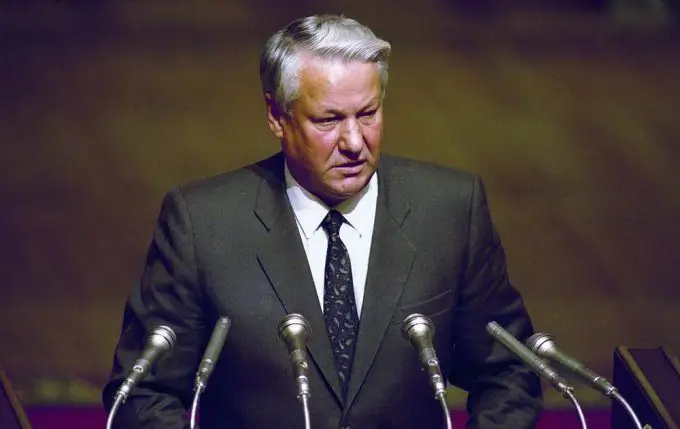- Author Antonio Harrison [email protected].
- Public 2023-12-16 07:44.
- Last modified 2025-01-22 21:44.
In the early 90s, the Soviet Union collapsed. Most of its constituent republics became independent, including Russia. Boris Nikolayevich Yeltsin became the first president of the new country.

Background
In the Soviet Union of the 1980s, events developed rapidly, the economic crisis, stagnation and shortages did not inspire confidence in the ruling elite in Moscow. One of the problems of the USSR, like most of the countries of the socialist camp, was the unviability of communism. The ideology that Vladimir Ilyich Lenin adhered to in the fight against monarchy and injustice turned out to be ineffective, to maintain life in socialist states, in one way or another, injections of large capital are needed, and this contradicts the idea of communism as such.
When the USSR was on the verge of collapse, the ruling circles of the Communist Party were still making vain attempts to keep the Union inviolable. In turn, the leadership of the republics did everything possible to disconnect from the union and proclaim independence.
Yeltsin's coming to power
Boris Nikolayevich Yeltsin in March 1989 was elected People's Deputy of the Soviet Union for the city of Moscow. He received more than 90 percent of the vote with a 90 percent turnout. The new candidate inspired confidence and aroused sympathy among the common people. A year later, he was elected chairman of the Supreme Council of the RSFSR. On June 12, the new government issued a declaration of Russia's independence, which provided for the supremacy of Russian power over Soviet power.
On June 12, 1991, following a popular referendum, the first presidential elections in the RSFSR were held. Boris Yeltsin, as a non-partisan candidate, won 57% of the vote and became the first popularly elected president of Russia.
In August of the same year, supporters of the Communist Party created the Emergency Situations Committee (GKChP) with the aim of preserving the Soviet Union. In the course of further events, one BMP was destroyed and three supporters of the newly elected president of the country were killed. The committee, which had existed for four days, was disbanded, and new union agreements were not signed. From that moment, the republics, one by one, began to proclaim their independence, the Baltic countries were among the first to leave the USSR.
But Yeltsin's final victory over the Soviet past was the events of late September 1993. The "October putsch" or "Yeltsin's coup" led to the final abolition of the Soviet republic and the establishment of a presidential one. In the course of these events, about 130 people died and more than three hundred were injured.
Formally, Yeltsin became president of Russia in 1991 in the country's first democratic elections. But the final point on this issue was put by the events of 1993, when Soviet power was finally abolished and Russia became an independent state with a legally elected president.






